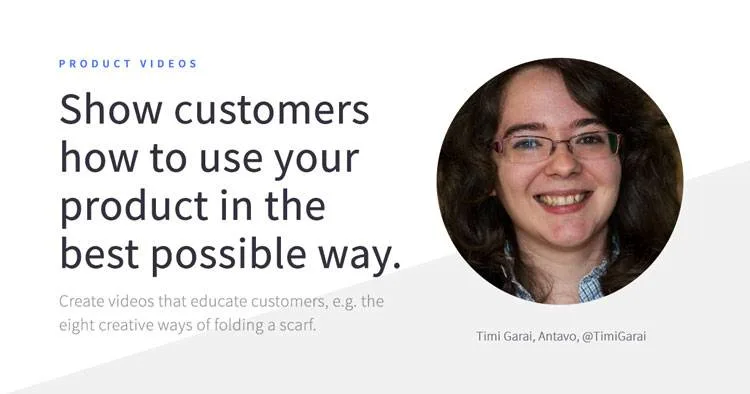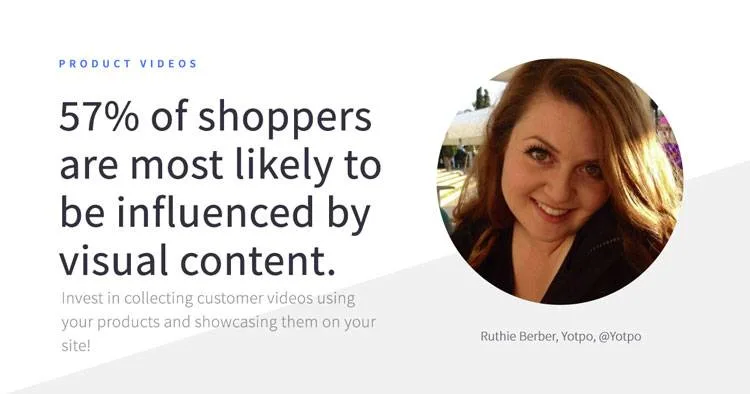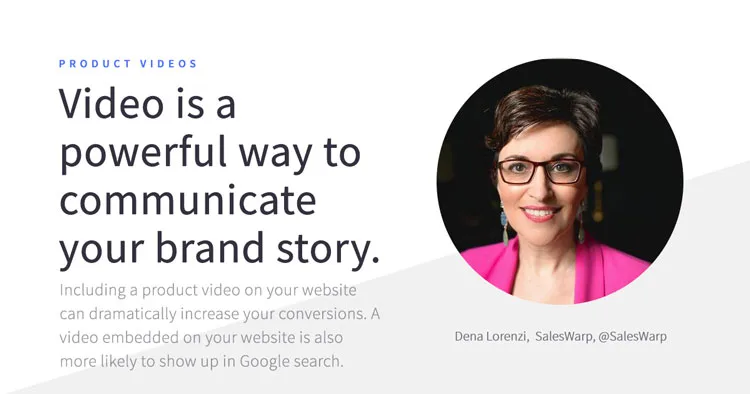31 Ecommerce Product Video Tips to Increase Trust, Engagement and Conversion
Tracey Wallace

Shooting photos and videos is no longer reserved for professionals.
You can easily shoot quality photos and HD video clips using your smartphone or consumer camera.
Here are a few tips and best practices to help you take professional quality photos and product videos for half the price (read on to get 16 more tips from ecommerce experts):
Avoid shaky video: Steady your phone or camera with a purchased tripod, or create a makeshift tripod out of books, a chair or whatever else you can get your hands on. Be creative.
Get the shot: Take a variety of photos and videos from different angles and then choose the best ones to include in your final video.
Focus on the product: When shooting photos and videos of your product, make sure to place it on a background that won’t be distracting to the viewer. A black or white background works nicely, as it allows the viewer to focus on the product.
Show scale: When showcasing a product, you may want to display it in a way that shows how big it is. This is especially important for items like jewelry or knick-knacks that are designed to be displayed. For jewelry, you can showcase the item on a person to accomplish this. For other items, place a ruler or another recognizable object in the frame.
Avoid vertical video: Turn your phone on its side and shoot in landscape. Vertical video looks unprofessional when presented in a traditional video player.
Lighting
Lighting helps a lot when it comes to shooting professional looking photos and videos.
Just take a look at the example below. These photos were shot under the same conditions –– same room, same camera position, same subject. The only thing that changed was the lighting. As you can see, it makes a big difference.

Here are some basic lighting tips that will help take your photos and video footage from so-so to great:
Shoot in a well-lit area for the sharpest, best looking footage. If you can, try shooting outside or in an interior space with large windows that let in lots of sunlight.
If you’re not near a bright natural light source, turn on all the lights in the room. If it’s still too dark, bring in some extra lamps.
When setting up direct light sources, keep an eye out for unappealing shadows. If you’re planning to shoot a large number of product videos, it may be worthwhile to invest in a light box or professional lighting kit. This will ensure that the lighting looks consistent across all of your product photos and videos.
Recommended Posts
Audio
Audio can also make or break things for your video. You know this is true. Think about those times you’ve tried to sit through videos with terrible audio. It’s distracting at best, and a death sentence for the video at worst.
If your video has crackly audio or a voice over that viewers can’t hear or understand, they just won’t watch.
Here are some tips for making sure that your audio isn’t detrimental to the success of your video:
Shoot in a quiet spot. Background noise can be distracting.
If you don’t have an external microphone, make sure your camera is close enough to your subject to pick up their voice.
Test your levels before you shoot. Plug headphones into your camera so you can hear how the audio sounds. Record a test clip and then play it back to see how it sounds.
Pro Tip
Understand that if you don’t have an external microphone you may not be able to record quality audio. In this case, try using background music and telling your story through titles and captions instead of having someone talk.
21 Expert Ecommerce Video Tips
Creating the perfect product video is equal part art and science –– which is why we went to talk to some of the ecommerce industry’s leading brand managers, consultants and video experts.
Here’s what they have to say about why and where to use product videos to increase sales (and be sure to check out our list of 17 brands who’ve gone above and beyond with ecommerce videos when you’re done).
William Harris, Ecommerce Consultant, Elumynt

People still want to see very real reviews of your products. They want to see how they hold up in real-world conditions. I have a client that sells radio-controlled cars. When they launched a product review of one of the new vehicles, their video quickly gathered up over 75,000 views – and that was just their first real video on YouTube. That builds up brand awareness which can really help with conversions on site.
A.J. Ghergich, Founder & CEO, Ghergich.com

Video reviews (especially user generated) are pure gold! Setup an automate email to encourage buyers to upload a quick iPhone video review of your products. Include a bullet point script and example video.
Also, offer a compelling incentive for them to do this.
Drew Sanocki, Founder, Nerd Marketing

You should be thinking of a video-first content marketing strategy. Facebook rewards video big time — with further reach and better engagement than basic static ads. Think Kickstarter videos. you should create one for your top products and try to get lazy people hanging out on Facebook to engage.
Igor Lebovic, CEO, Kindly Care

The current era of SEO is all about engagement. If you can get users to spend more time on site, and ideally even click around, Google will interpret those actions as signs of trust and content/market fit. Video can be used strategically to achieve those goals.
Chris Van Dusen, CEO, Parcon Media

The trend these days seems to be more on the lifestyle or emotion behind the brands, rather than just focusing on the products they are selling. Letting your audience know what the brand is passionate about can bring them in even closer and create that brand loyalty you need.
Alex Birkett, Growth Marketing Manager, ConversionXL

For ecommerce specifically, I love the use of videos on products pages.
Shopping online has the implicit limitation of its virtual environment. You can’t hold and experience the product.
Video brings you one step closer to bridging that gap, making it easier to envision what a product would be like. It usually increases conversions, too
Video testimonials are great, too, and something that Amazon has really capitalized on.
Timi Garai, Marketing Manager, Antavo

Create videos that educate customers, e.g. the eight creative ways of folding a scarf. Customers want to know how to use your product in the best possible way. Show them that you care about their need by sharing inspiring examples and tutorials about using your products.
Ask famous vloggers who are influencers to promote your product(s). You can give them a free sample to test it in their videos, or you can run a sweepstakes together and give away one of your products as a prize. This can help you to get more word-of-mouth marketing and therefore more sales.
Jan Lastuvka, CEO & Co-Founder, MonkeyData

Videos are a more engaging medium than product images or text, and can do wonders to increase your conversion rates.
Also, they have less friction and you can put as much information in 30 seconds of video as you can in half a page of text –– which visitors will likely not have the patience to read anyway.
There are many creative ways that you can use video to help boost your sales.
Create product demonstration videos. These will help show people how your product is used. This is especially important if your product is complicated to use.
Do an unboxing video. Get an influencer in your niche to do an unboxing of your product and explain all the great features inside. This is especially valuable if you use unique and interesting packaging for your products.
Take advantage of user-generated content. Get your customers to post video reviews of the product or get them to create videos of them using the product. You can also incorporate this as part of a contest to encourage people to participate.
Zach Heller, Marketer, Author at ZachHeller.com

Video can be a great tool to give your potential customers a demonstration of the product unlike anything you can do in still images or written descriptions. Show them how it works and let them “see themselves” with your product.
Everett Sizemore, Director of Marketing, Inflow

Video is a great opportunity to deliver an exceptional user experience on category pages.
A short ~30 second clip explaining the differences between the brands, models or whatever options they have to drill down into, is much better than several paragraphs of SEO copy that do nothing for the user but make them have to scroll further to see the category listings.
An optimized header tag in addition to providing a transcript of the video will take care of the textual keyword part.
And, of course, product demonstration videos are perfect for product pages, while unboxing and demonstration videos can also drive traffic from YouTube.
Jamie Turner, CEO, 60 Second Marketer

There are two secrets to ecommerce videos.
The first is that the visitor must think “This video was created specifically for me.” The more relevant the video, the more likely the visitor will come back.
The second is to create some sort of entertainment value behind the video. That doesn’t mean it has to be funny. It just means it has to carry the viewer along in an engaging fashion.
Jason Dea, Director Product Marketing, Intelex

Video is a highly shareable and very easy to consume consent type that many brands can take advantage of.
In fact it’s the most highly shared type of content in almost every social channel.
That’s because video is an ideal medium for brands to distill their message and value proposition down into bite sized pieces with.
The great thing is that the cost of producing high quality video content has come down tremendously as well, from professional grade tools that are reasonable for beginners to learn, to boutique production houses that cater to small businesses.
Andy Etemadi, CEO, Eyemagine

High-fidelity video content can suspend doubt, deliver impactful product knowledge and expose the product to an audience that consumes video more readily than text copy.
Jeff Sauer, Founder, Jeffalytics

Have you ever bought a product based on the demo video alone? I have many times, and I keep doing it every time a new video comes out.
Call me a Kickstarter junkie or just easily inspired, but a well done product video is the best way to take an unaware prospect and turn them into a loyal customer.
Apple, DJI drones and Peak design are all examples of videos done great.
Taylor Sicard, VP of Growth, Rare.io

Video marketing is part of content marketing. Ecommerce businesses should see video as another way to add value to consumers, not just a sales channel.
Looking at the most viral videos on social media, short and positive videos tend to perform better as it’s easy to consume and give a positive experience.
Ecommerce businesses should leverage the same principles to create engaging video content that are easy to share and get people to engage with it.
Annie Cushing, Founder, Annielytics

Brands should be capitalizing on video to improve their user experience, SEO and social media presence.
On the social media front, a brand can use the same video on Snapchat, Instagram, Facebook, etc. Then they can upload it to YouTube to take advantage of the second largest search engine in the world. And finally, they can upload the video to their site to delight their customers.
Ruthie Berber, Co-Marketing Manager, Yotpo

Shoppers trust customer content, like user-generated visuals and reviews, over promotional or branded content. And, the influence of photos and videos is definitely on the rise.
A Yotpo survey of more than 100,000 shoppers in 2016 shows that 57% of shoppers say they are most likely to be influenced by visual customer content when making purchase decisions.
My top tip for ecommerce stores: invest in collecting customer videos using your products and showcasing them on your site!
Adii Pienaar, Founder, Conversio

I’m the founder of a software company and I’m pretty technical. This means that I can spot an online ad from a mile away and have mostly developed “(online) ad blindness” as a result. I almost never click on ads.
But on Facebook, I often find myself clicking on and watching Tasty’s videos. Just last week, I found myself drooling whilst watching them share this amazing recipe for Mexican Pork Taco’s. WANT!
Why is that then that I mostly ignore ads, but Tasty’s videos gets me engaged?
Video is such a rich medium and when the content is well-produced and unique, it just draws a viewer in. Due to the richness, it also appeals to many more senses, which inherently makes it a more engaging experience for the viewer (compared to just text or static images for example).
My tip will thus be a simple one:
The starting point should be to produce unique video content (that shows of your brand and personality) to augment your marketing efforts. In this way, you’re giving your customers another way in which they can engage with you and immerse themselves in your brand.
Jacob Firuta, Content Manager, LiveChat

Show the product in action, especially when you can show how it solves a particular problem.
Buyers always want more information before making a purchase. A product video allows you to answer some of their doubts by showing the intended use for the product you’re trying to pitch in short, easy to digest form.
Dena Lorenzi, Marketing Manager, SalesWarp

Video is a powerful way to communicate your brand story and build relationships with your clients and prospects. Ecommerce brands can use explainer videos to show how their products or services work.
Including a product video on your website can dramatically increase your conversions. A video embedded on your website is also more likely to show up in Google search.
Another way to grow your business is by making a video testimonial. Customer testimonials offer prospects third-party proof, thereby helping ecommerce owners build trust with their audience.

Tracey is the Director of Marketing at MarketerHire, the marketplace for fast-growth B2B and DTC brands looking for high-quality, pre-vetted freelance marketing talent. She is also the founder of Doris Sleep and was previously the Head of Marketing at Eterneva, both fast-growth DTC brands marketplaces like MarketerHire aim to help. Before that, she was the Global Editor-in-Chief at BigCommerce, where she launched the company’s first online conference (pre-pandemic, nonetheless!), wrote books on How to Sell on Amazon, and worked closely with both ecommerce entrepreneurs and executives at Fortune 1,000 companies to help them scale strategically and profitably. She is a fifth generation Texan, the granddaughter of a depression-era baby turned WWII fighter jet pilot turned self-made millionaire, and wifed up to the truest of heroes, a pediatric trauma nurse, who keeps any of Tracey’s own complaints about business, marketing, or just a seemingly lousy day in perspective.